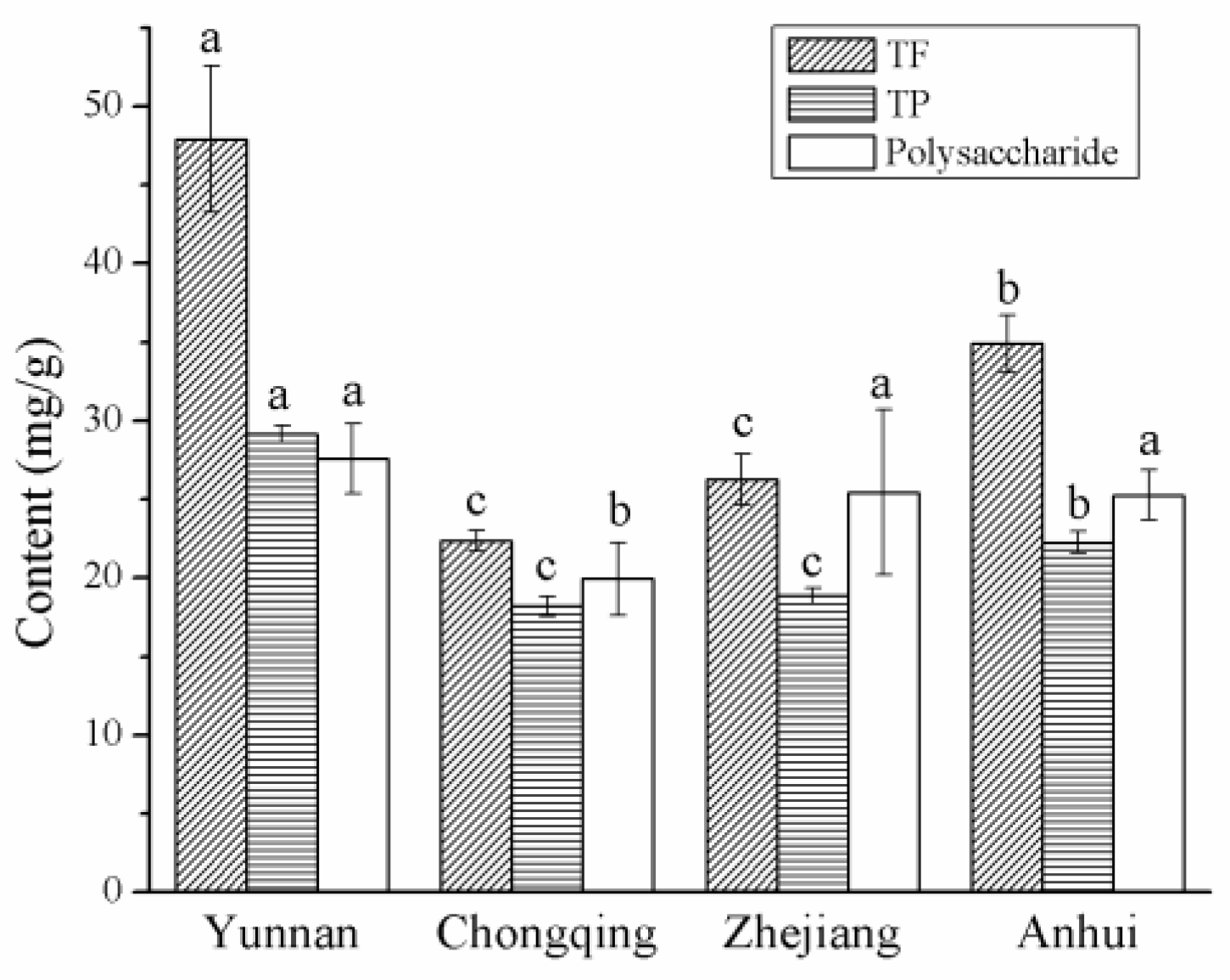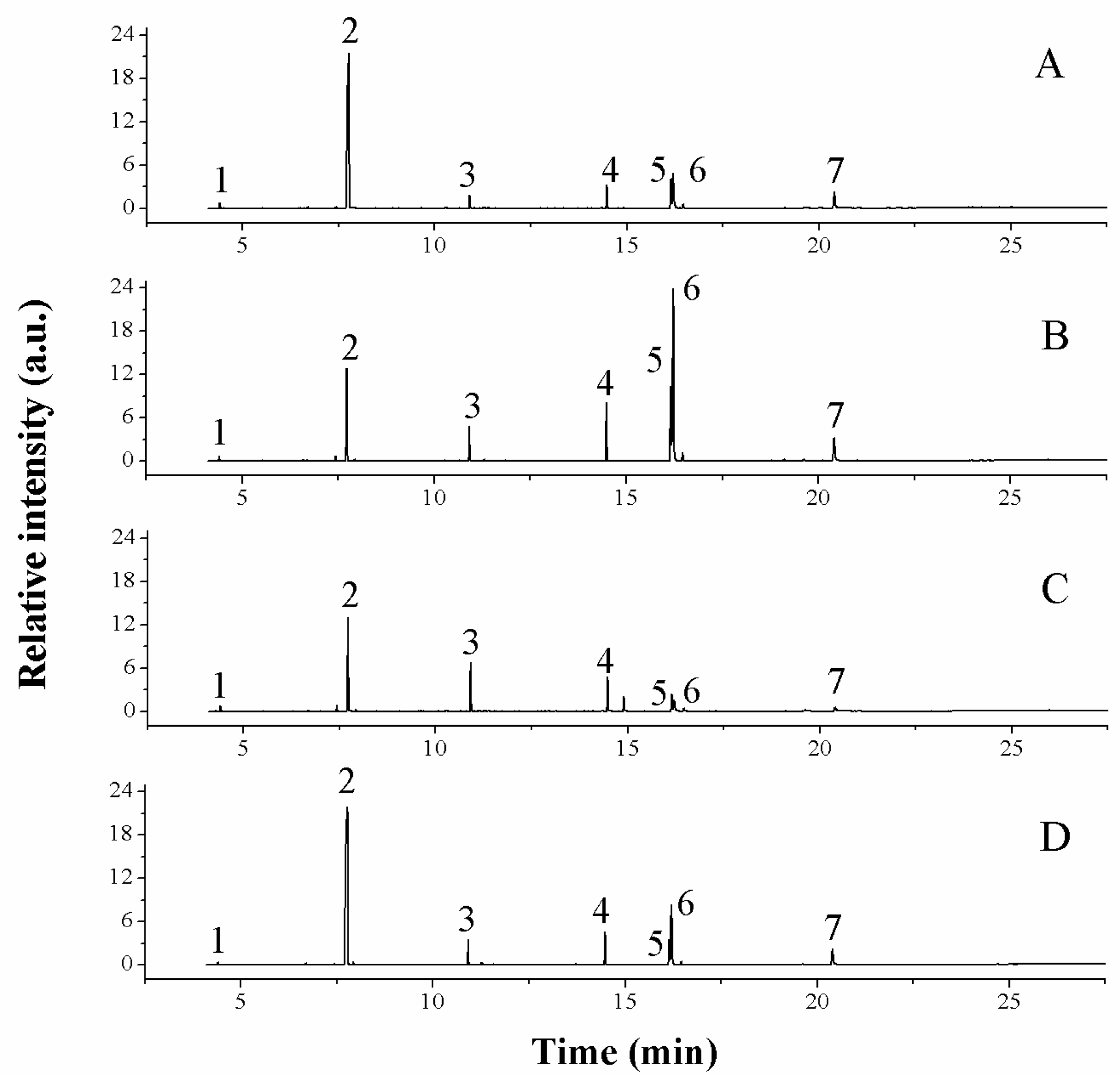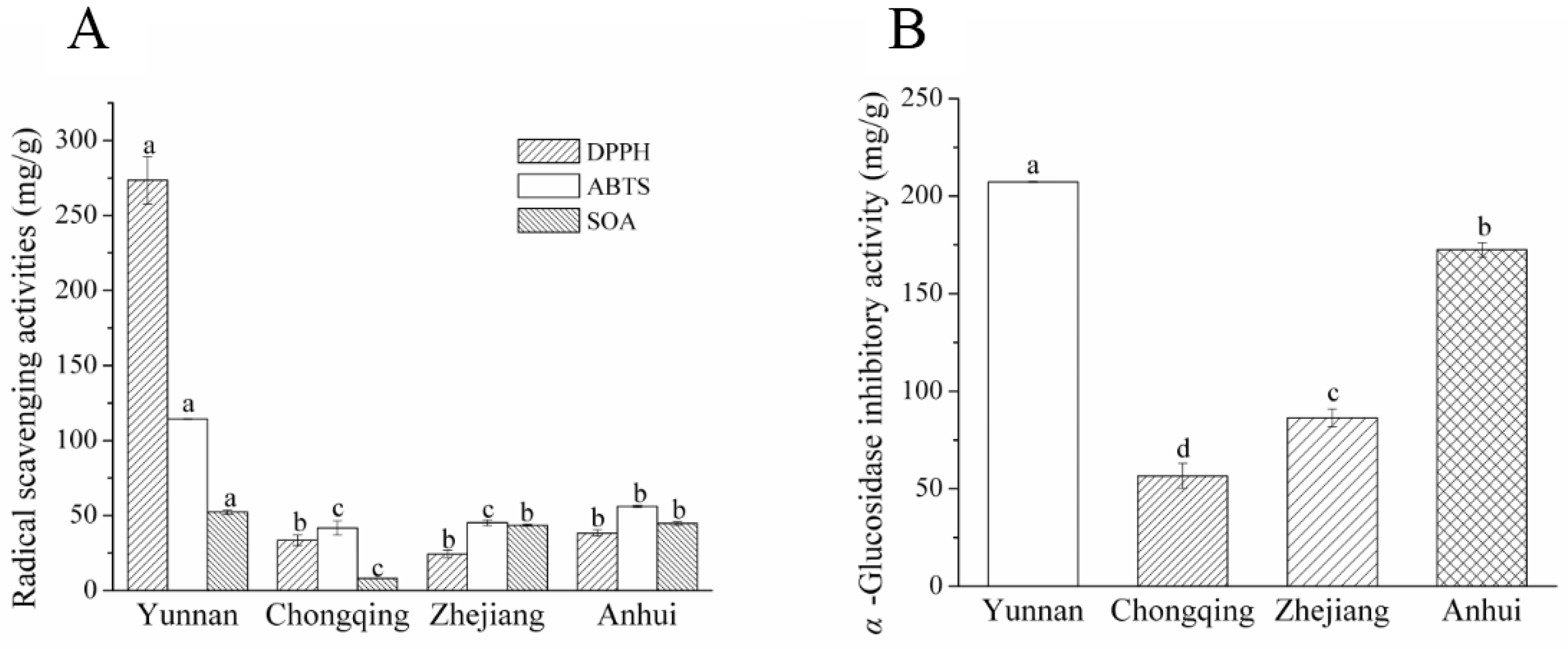Chemical Composition, Antioxidant Activity and α-Glucosidase Inhibitory Activity of Chaenomeles Speciosa from Four Production Areas in China
Abstract
:1. Introduction
2. Results and Discussion
2.1. Chemical Composition of C. speciosa from Four Production Areas in China
2.1.1. TF, TP and Polysaccharide Contents
2.1.2. Free Amino Acid Content
2.1.3. Organic Acid Content
2.1.4. OA and UA Contents
2.2. Antioxidant Activity and α-Glucosidase Inhibitory Activity of C. speciosa
2.3. Correlation Analysis
3. Materials and Methods
3.1. Plant Materials and Reagents
3.2. Analysis of Chemical Composition
3.2.1. Analysis of TF and TP
3.2.2. Polysaccharide Analysis
3.2.3. Free Amino Acid Analysis
3.2.4. Organic Acid Analysis
3.2.5. Analysis of OA and UA Contents
3.3. Antioxidant Activity
3.4. α-Glucosidase Inhibitory Activity
3.5. Statistical Analysis
4. Conclusions
Author Contributions
Funding
Conflicts of Interest
References
- Du, H.; Wu, J.; Li, H.; Zhong, P.X.; Xu, Y.J.; Li, C.H.; Ji, K.X.; Wang, L.S. Polyphenols and triterpenes from Chaenomeles fruits: chemical analysis and antioxidant activities assessment. Food Chem. 2013, 141, 4260–4268. [Google Scholar] [CrossRef] [PubMed]
- Zhang, S.Y.; Han, L.Y.; Zhang, H.; Xin, H.L. Chaenomeles speciosa: A review of chemistry and pharmacology. Biomed. Rep. 2014, 2, 12–18. [Google Scholar] [CrossRef] [PubMed]
- Zhang, L.; Cheng, Y.X.; Liu, A.L.; Wang, H.D.; Wang, Y.L.; Du, G.H. Antioxidant, anti-inflammatory and anti-influenza properties of components from Chaenomeles speciosa. Molecules 2010, 15, 8507–8517. [Google Scholar] [CrossRef] [PubMed]
- Xie, X.F.; Cai, X.Q.; Zhu, S.Y.; Zou, G.L. Chemical composition and antimicrobial activity of essential oils of Chaenomeles speciosa from China. Food Chem. 2007, 100, 1312–1315. [Google Scholar] [CrossRef]
- Zhao, G.; Jiang, Z.H.; Zheng, X.W.; Zang, S.Y.; Guo, L.H. Dopamine transporter inhibitory and antiparkinsonian effect of common flowering quince extract. Pharmacol. Biochem. Behav. 2008, 90, 363–371. [Google Scholar] [CrossRef] [PubMed]
- Kylli, P.; Nohynek, L.; Puupponen-Pimia, R.; Westerlund-Wikstrom, B.; Leppanen, T.; Welling, J.; Moilanen, E.; Heinonen, M. Lingonberry (Vaccinium vitis-idaea) and European cranberry (Vaccinium microcarpon) proanthocyanidins: isolation, identification, and bioactivities. J. Agric. Food Chem. 2011, 59, 3373–3384. [Google Scholar] [CrossRef] [PubMed]
- Dykes, L.; Rooney, L.W. Phenolic compounds in cereal grains and their health benefits. Cereal Food. World 2007, 52, 105–111. [Google Scholar] [CrossRef]
- Xie, X.F.; Zou, G.L.; Li, C.H. Purification, characterization and in vitro antioxidant activities of polysaccharide from Chaenomeles speciosa. Int. J. Biol. Macromol. 2016, 92, 702–707. [Google Scholar] [CrossRef] [PubMed]
- Xie, X.F.; Zou, G.L.; Li, C.H. Antitumor and immunomodulatory activities of a water-soluble polysaccharide from Chaenomeles speciosa. Carbohydr. Polym. 2015, 132, 323–329. [Google Scholar] [CrossRef] [PubMed]
- Singh, G.B.; Singh, S.; Bani, S.; Gupta, B.D.; Banerjee, S.K. Anti-inflammatory activity of oleanolic acid in rats and mice. J. Pharm. Pharmacol. 1992, 44, 456–458. [Google Scholar] [CrossRef] [PubMed]
- Gao, D.; Tang, S.; Tong, Q. Oleanolic acid liposomes with polyethylene glycol modification: Promising antitumor drug delivery. Int. J. Nanomed. 2012, 7, 3517–3526. [Google Scholar] [CrossRef] [PubMed]
- Shyu, M.H.; Kao, T.C.; Yen, G.C. Oleanolic acid and ursolic acid induce apoptosis in HuH7 human hepatocellular carcinoma cells through a mitochondrial-dependent pathway and downregulation of XIAP. J. Agric. Food Chem. 2010, 58, 6110–6118. [Google Scholar] [CrossRef] [PubMed]
- Miao, J.; Wei, K.; Li, X.; Zhao, C.; Chen, X.; Mao, X.; Huang, H.; Gao, W. Effect of boiling and drying process on chemical composition and antioxidant activity of Chaenomeles speciosa. J. Food. Sci. Technol. 2017, 54, 2758–2768. [Google Scholar] [CrossRef] [PubMed]
- Miao, J.; Zhao, C.; Li, X.; Chen, X.; Mao, X.; Huang, H.; Wang, T.; Gao, W. Chemical composition and bioactivities of two common chaenomeles fruits in China: Chaenomeles speciosa and Chaenomeles sinensis. J. Food. Sci. 2016, 81, H2049–H2058. [Google Scholar] [CrossRef] [PubMed]
- Miao, J.; Li, X.; Zhao, C.; Gao, X.X.; Wang, Y.; Cheng, K.F.; Gao, W.Y. Solvents effect on active chemicals and activities of antioxidant, anti-α-glucosidase and inhibit effect on smooth muscle contraction of isolated rat jejunum of Chaenomeles speciosa. J. Funct. Foods 2018, 40, 146–155. [Google Scholar] [CrossRef]
- Miao, J.; Li, X.; Zhao, C.; Gao, X.; Wang, Y.; Gao, W. Active compounds, antioxidant activity and alpha-glucosidase inhibitory activity of different varieties of Chaenomeles fruits. Food Chem. 2018, 248, 330–339. [Google Scholar] [CrossRef] [PubMed]
- Gan, R.Y.; Kuang, L.; Xu, X.R.; Zhang, Y.; Xia, E.Q.; Song, F.L.; Li, H.B. Screening of natural antioxidants from traditional Chinese medicinal plants associated with treatment of rheumatic disease. Molecules 2010, 15, 5988–5997. [Google Scholar] [CrossRef] [PubMed]
- Liu, S.Y. Studying on Organic Acids Composition Of Chaenomeles Speciosa (Sweet) Nakai Fruit From Different Producing Areas, Isolation and Purification of Its’s Main Functional Components. Ph.D. Thesis, Southwest University, Chongqing, China, 2012. [Google Scholar]
- Chang, C.T.; You, C.F.; Aggarwal, S.K.; Chung, C.H.; Chao, H.C.; Liu, H.C. Boron and strontium isotope ratios and major/trace elements concentrations in tea leaves at four major tea growing gardens in Taiwan. Environ. Geochem. Health. 2016, 38, 737–748. [Google Scholar] [CrossRef] [PubMed]
- Jia, Z.S.; Tang, M.C.; Wu, J.M. The determination of flavonoid contents in mulberry and their scavenging effects on superoxide radicals. Food Chem. 1999, 64, 555–559. [Google Scholar] [CrossRef]
- Lamuela-Raventós, R.M.; Singleton, V.L.; Orthofer, R. Analysis of total phenols and other oxidation substrates and antioxidants by means of folin-ciocalteu reagent. In Methods in Enzymology; Wiley & Sons: New York, NY, USA, 1999; pp. 152–178. 004p. [Google Scholar]
- General Administration of Quality Supervision, Inspection and Quarantine of the People’s Republic of China. Determination of crude polysaccharides in plant source foods for export-phenol-sulfuric acid colorimetry. In Entry-Exit Inspection and Quarantine industry standards of China, 1st ed.; Standards Press of China: Beijing, China, 2016. [Google Scholar]
- Fierabracci, V.; Masiello, P.; Novelli, M.; Bergamini, E. Application of amino acid analysis by high-performance liquid chromatography with phenyl isothiocyanate derivatization to the rapid determination of free amino acids in biological samples. J. Chromatogr. B Biomed. Sci. Appl. 1991, 570, 285–291. [Google Scholar] [CrossRef]
- Chinese Pharmacopoeia Commission. Phrmacopoeia of the People’s Republic of China; People’s Medical Publishing House: Beijing, China, 2005; pp. 87–88. ISBN 978-7502529819. [Google Scholar]
- Brisdelli, F.; Perilli, M.; Sellitri, D.; Piovano, M.; Garbarino, J.A.; Nicoletti, M.; Bozzi, A.; Amicosante, G.; Celenza, G. Cytotoxic activity and antioxidant capacity of purified lichen metabolites: An in vitro study. Phytother. Res. 2013, 27, 431–437. [Google Scholar] [CrossRef]
- Ang, L.Z.P.; Hashim, R.; Sulaiman, S.F.; Coulibaly, A.Y.; Sulaiman, O.; Kawamura, F.; Salleh, K.M. In vitro antioxidant and antidiabetic activities of Gluta torquata. Ind. Crops Prod. 2015, 76, 755–760. [Google Scholar] [CrossRef]
- Hirota, S.; Shimoda, T.; Takahama, U. Tissue and spatial distribution of flavonol and peroxidase in onion bulbs and stability of flavonol glucosides during boiling of the scales. J. Agric. Food Chem. 1998, 46, 3497–3502. [Google Scholar] [CrossRef]
- Ma, C.M.; Sato, N.; Li, X.Y.; Nakamura, N.; Hattori, M. Flavan-3-ol contents, anti-oxidative and α-glucosidase inhibitory activities of Cynomorium songaricum. Food Chem. 2010, 118, 116–119. [Google Scholar] [CrossRef]
Sample Availability: Samples of C. speciosa are available from the authors. |



| Free Amino Acids | Content (mg/kg) in Samples from Each Region | |||
|---|---|---|---|---|
| Yunnan | Chongqing | Zhejiang | Anhui | |
| Aspartic acid | 149.59 ± 17.04 b | 126.30 ± 7.43 b | 129.90 ± 9.50 b | 263.09 ± 34.02 a |
| Glutamic acid | 298.59 ± 22.74 a | 98.47 ± 4.70 c | 140.77 ± 12.98 b | 133.99 ± 23.63 b |
| Cysteine | 38.64 ± 1.28 b | 44.87 ± 1.97 a | 38.70 ± 0.95 b | 37.95 ± 3.59 b |
| Serine | 1115.38 ± 56.82 a | 381.12 ± 30.28 b | 1036. 40 ± 67.80 a | 1144.61 ± 109.20 a |
| Glycine | 45.01 ± 0.68 a | 36.45 ± 2.93 b | 33.17 ± 1.88 b | 28.63 ± 3.12 c |
| Histidine | 65.16 ± 1.55 b | 51.10 ± 0.91 c | 73.10 ± 0.85 a | 46.30 ± 3.54 d |
| Arginine | 729.13 ± 15.20 a | 329.85 ± 51.32 c | 673.70 ± 25.82 c | 600.75 ± 62.15 c |
| Threonine | 26.58 ± 0.88 a | 5.94 ± 0.56 c | 26.10 ± 4.20 a | 20.78 ± 2.32 b |
| Alanine | 183.20 ± 20.71 a | 79.75 ± 2.90 c | 56.07 ± 1.69 c | 118.78 ± 14.19 b |
| Proline | 106.64 ± 25.75 c | 278.21 ± 4.99 b | 382.63 ± 23.17 a | 294.51 ± 60.17 b |
| Tyrosine | 47.35 ± 1.92 b | 36.94 ± 3.91 c | 59.73 ± 1.61 a | 33.26 ± 0.57 c |
| Valine | 51.42 ± 1.97 a | 33.97 ± 1.69 b | 30.40 ± 0.62 c | 31.61 ± 1.55 b,c |
| Methionine | 30.29 ± 4.54 b | 30.32 ± 0.78 b | 33.63 ± 0.31 a,b | 35.79 ± 0.62 a |
| Isoleucine | 13.78 ± 0.75 b | 30.43 ± 3.43 a | 14.27 ± 0.47 b | 16.14 ± 4.45 b |
| Leucine | 9.41 ± 1.49 c | 21.25 ± 2.86 b | 34.23 ± 1.40 a | 19.87 ± 6.61 b |
| Phenylalanine | 107.75 ± 6.63 a | 43.60 ± 2.46 c | 44.10 ± 1.51 c | 55.41 ± 4.22 b |
| Lysine | 25.35 ± 1.67 b | 24.09 ± 0.99 b,c | 44.07 ± 2.65 a | 21.03 ± 1.74 c |
| Tryptophan | 368.33 ± 16.92 c | 634.00 ± 13.75 a | 375.33 ± 31.02 c | 447.33 ± 15.82 b |
| Total amino acids | 3411.60 | 2286.66 | 3226.30 | 3349.83 |
| Essential amino acids | 632.91 | 823.60 | 602.13 | 647.96 |
| Organic Acids | Retention Time (min) | Percentage (%) in Samples from Each Region | |||
|---|---|---|---|---|---|
| Yunnan | Chongqing | Zhejiang | Anhui | ||
| Oxalic acid | 4.37 | 1.08 | 0.89 | 2.00 | 0.39 |
| Propanedioic acid | 5.51 | 0.11 | 0.13 | 0.23 | 0.13 |
| Fumaric acid | 6.59 | 0.07 | 0.20 | 0.13 | 0.14 |
| Succinic acid | 6.69 | 0.26 | 0.24 | 0.42 | 0.24 |
| Benzoic acid | 7.43 | 0.34 | 0.74 | 2.31 | 0.35 |
| Malic acid | 7.76 | 66.77 | 16.51 | 40.58 | 63.06 |
| Dimethyoxy succinate | 7.93 | 0.15 | 0.27 | 0.85 | 0.49 |
| Cinnamic acid | 10.26 | 0.12 | 0.17 | 0.38 | 0.09 |
| Trans-aconitic acid | 10.63 | 0.12 | 0.13 | 0.19 | 0.13 |
| Citric acid | 10.93 | 2.05 | 4.22 | 14.86 | 3.17 |
| Isocitrate | 11.27 | 0.28 | 0.19 | 0.41 | 0.35 |
| Azelaic acid | 11.56 | 0.03 | 0.09 | 0.20 | 0.10 |
| Phthalic acid | 14.08 | 0.06 | 0.06 | 0.17 | 0.20 |
| Palmitic acid | 14.48 | 4.48 | 9.07 | 13.65 | 5.59 |
| Linoleic acid | 16.15 | 6.21 | 15.95 | 8.37 | 4.76 |
| Oleic acid | 16.21 | 10.86 | 41.77 | 9.47 | 14.73 |
| Stearic acid | 16.47 | 0.89 | 1.70 | 1.71 | 0.81 |
| Arachidonic acid | 19.10 | 0.12 | 0.46 | 0.15 | 0.16 |
| 10-Hydroxy-hexadecanoic acid | 20.41 | 6.00 | 7.20 | 3.92 | 5.11 |
| Total | 100.00 | 100.00 | 100.00 | 100.00 | |
| Organic Acids | Retention Time (min) | Content (mg/g) in Samples from Each Region | |||
|---|---|---|---|---|---|
| Yunnan | Chongqing | Zhejiang | Anhui | ||
| Oxalic acid | 4.37 | 3.20 ± 0.05 a | 2.97 ± 0.18 a | 2.84 ± 0.07 a | 1.33 ± 0.08 b |
| Malic acid | 7.76 | 124.96 ± 7.43 a | 34.81 ± 0.35 b | 32.86 ± 0.05 b | 139.91 ± 4.24 a |
| Citric acid | 10.93 | 10.26 ± 0.35 d | 22.53 ± 0.03 b | 30.91 ± 0.11 a | 17.54 ± 0.38 c |
| Palmitic acid | 14.48 | 5.78 ± 0.28 c | 12.04 ± 0.02 a | 7.41 ± 0.07 b | 7.45 ± 0.13 b |
| Stearic acid | 16.47 | 1.05 ± 0.004 b | 2.23 ± 0.08 a | 1.16 ± 0.10 b | 1.09 ± 0.01 b |
| Triterpenic Acids | Content (μg/g) in Samples from Each Region | |||
|---|---|---|---|---|
| Yunnan | Chongqing | Zhejiang | Anhui | |
| OA | 90.64 ± 7.87 c | 79.95 ± 9.21 c | 555.98 ± 20.88 a | 261.87 ± 19.12 b |
| UA | 339.97 ± 11.86 a | 251.56 ± 8.44 b | 164.91 ± 6.70 c | 321.06 ± 14.64 a |
| Total | 430.61 | 331.51 | 720.89 | 582.93 |
| Chemical Component | DPPH | ABTS | SOA | α-Glucosidase Inhibitory Activity | |
|---|---|---|---|---|---|
| TF | r | 0.88 | 0.94 | 0.74 | 0.97 |
| p | 0.0002 | <0.0001 | 0.01 | <0.0001 | |
| TP | r | 0.93 | 0.97 | 0.66 | 0.59 |
| p | <0.0001 | <0.0001 | 0.02 | 0.06 | |
| Polysaccharide | r | 0.51 | 0.59 | 0.81 | 0.68 |
| p | 0.09 | 0.04 | 0.001 | 0.02 | |
| OA | R | −0.50 | −0.42 | 0.35 | −0.47 |
| p | 0.10 | 0.18 | 0.27 | 0.15 | |
| UA | r | 0.61 | 0.65 | 0.27 | −0.53 |
| p | 0.04 | 0.02 | 0.40 | 0.09 |
© 2018 by the authors. Licensee MDPI, Basel, Switzerland. This article is an open access article distributed under the terms and conditions of the Creative Commons Attribution (CC BY) license (http://creativecommons.org/licenses/by/4.0/).
Share and Cite
Zheng, X.; Wang, H.; Zhang, P.; Gao, L.; Yan, N.; Li, P.; Liu, X.; Du, Y.; Shen, G. Chemical Composition, Antioxidant Activity and α-Glucosidase Inhibitory Activity of Chaenomeles Speciosa from Four Production Areas in China. Molecules 2018, 23, 2518. https://doi.org/10.3390/molecules23102518
Zheng X, Wang H, Zhang P, Gao L, Yan N, Li P, Liu X, Du Y, Shen G. Chemical Composition, Antioxidant Activity and α-Glucosidase Inhibitory Activity of Chaenomeles Speciosa from Four Production Areas in China. Molecules. 2018; 23(10):2518. https://doi.org/10.3390/molecules23102518
Chicago/Turabian StyleZheng, Xuan, Hongwei Wang, Peng Zhang, Lin Gao, Ning Yan, Panpan Li, Xinmin Liu, Yongmei Du, and Guoming Shen. 2018. "Chemical Composition, Antioxidant Activity and α-Glucosidase Inhibitory Activity of Chaenomeles Speciosa from Four Production Areas in China" Molecules 23, no. 10: 2518. https://doi.org/10.3390/molecules23102518
APA StyleZheng, X., Wang, H., Zhang, P., Gao, L., Yan, N., Li, P., Liu, X., Du, Y., & Shen, G. (2018). Chemical Composition, Antioxidant Activity and α-Glucosidase Inhibitory Activity of Chaenomeles Speciosa from Four Production Areas in China. Molecules, 23(10), 2518. https://doi.org/10.3390/molecules23102518




